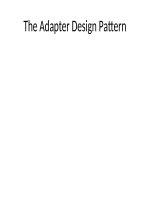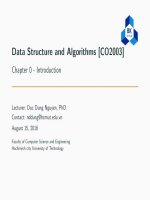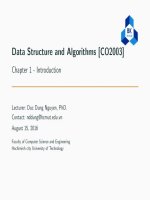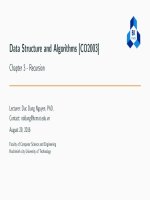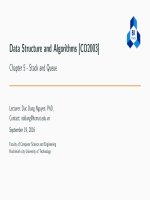C++ programming program design including data structure 7th ch02
Bạn đang xem bản rút gọn của tài liệu. Xem và tải ngay bản đầy đủ của tài liệu tại đây (664.73 KB, 73 trang )
Chapter 2:
Basic Elements of C++
Objectives
• In this chapter, you will:
– Become familiar with the basic components of a C++
program, including functions, special symbols, and
identifiers in C++
– Explore simple data types
– Discover how to use arithmetic operators
– Examine how a program evaluates arithmetic expressions
– Become familiar with the string data type
– Learn what an assignment statement is and what it does
C++ Programming: Program Design Including Data Structures, Seventh Edition
2
Objectives (cont’d.)
– Learn about variable declaration
– Discover how to input data into memory using input
statements
– Become familiar with the use of increment and decrement
operators
– Examine ways to output results using output statements
– Learn how to use preprocessor directives and why they are
necessary
C++ Programming: Program Design Including Data Structures, Seventh Edition
3
Objectives (cont’d.)
– Learn how to debug syntax errors
– Explore how to properly structure a program, including
using comments to document a program
– Become familiar with compound statements
– Learn how to write a C++ program
C++ Programming: Program Design Including Data Structures, Seventh Edition
4
Introduction
• Computer program
– Sequence of statements whose objective is to accomplish a
task
• Programming
– Process of planning and creating a program
• Real-world analogy: a recipe for cooking
C++ Programming: Program Design Including Data Structures, Seventh Edition
5
A Quick Look at a C++ Program
C++ Programming: Program Design Including Data Structures, Seventh Edition
6
A Quick Look at a C++ Program
(cont’d.)
• Sample run:
C++ Programming: Program Design Including Data Structures, Seventh Edition
7
A Quick Look at a C++ Program
(cont’d.)
C++ Programming: Program Design Including Data Structures, Seventh Edition
8
A Quick Look at a C++
Program(cont’d.)
C++ Programming: Program Design Including Data Structures, Seventh Edition
9
A Quick Look at a C++
Program(cont’d.)
• Variable: a memory location whose contents can be
changed
Figure 2-2 Memory
allocation
Figure 2-3 Memory spaces after the statement length = 6.0;
executes
C++ Programming: Program Design Including Data Structures, Seventh Edition
10
The Basics of a C++ Program
• Function (or subprogram): collection of statements;
when executed, accomplishes something
– May be predefined or standard
• Syntax rules: rules that specify which statements
(instructions) are legal or valid
• Semantic rules: determine the meaning of the
instructions
• Programming language: a set of rules, symbols, and
special words
C++ Programming: Program Design Including Data Structures, Seventh Edition
11
Comments
• Comments are for the reader, not the compiler
• Two types:
– Single line: begin with //
// This is a C++ program.
// Welcome to C++ Programming.
– Multiple line: enclosed between /* and */
/*
You can include comments that can
occupy several lines.
*/
C++ Programming: Program Design Including Data Structures, Seventh Edition
12
Special Symbols
• Token: the smallest individual unit of a program
written in any language
• C++ tokens include special symbols, word symbols,
and identifiers
• Special symbols in C++ include:
C++ Programming: Program Design Including Data Structures, Seventh Edition
13
Reserved Words (Keywords)
• Reserved word symbols (or keywords):
– Cannot be redefined within program
– Cannot be used for anything other than their intended use
Examples:
–
–
–
–
–
–
–
int
float
double
char
const
void
return
C++ Programming: Program Design Including Data Structures, Seventh Edition
14
Identifiers
• Identifier: the name of something that appears in a
program
– Consists of letters, digits, and the underscore character (_)
– Must begin with a letter or underscore
• C++ is case sensitive
– NUMBER is not the same as number
• Two predefined identifiers are cout and cin
• Unlike reserved words, predefined identifiers may be
redefined, but it is not a good idea
C++ Programming: Program Design Including Data Structures, Seventh Edition
15
Identifiers (cont’d.)
• Legal identifiers in C++:
– first
– conversion
– payRate
C++ Programming: Program Design Including Data Structures, Seventh Edition
16
Whitespaces
• Every C++ program contains whitespaces
– Include blanks, tabs, and newline characters
• Used to separate special symbols, reserved words,
and identifiers
• Proper utilization of whitespaces is important
– Can be used to make the program more readable
C++ Programming: Program Design Including Data Structures, Seventh Edition
17
Data Types
• Data type: set of values together with a set of
operations
• C++ data types fall into three categories:
– Simple data type
– Structured data type
– Pointers
C++ Programming: Program Design Including Data Structures, Seventh Edition
18
Simple Data Types
• Three categories of simple data
– Integral: integers (numbers without a decimal)
• Can be further categorized:
– char, short, int, long, bool, unsigned
char, unsigned short, unsigned int,
unsigned long
– Floating-point: decimal numbers
– Enumeration type: user-defined data type
C++ Programming: Program Design Including Data Structures, Seventh Edition
19
Simple Data Types (cont’d.)
• Different compilers may allow different ranges of
values
C++ Programming: Program Design Including Data Structures, Seventh Edition
20
int Data Type
• Examples:
-6728
0
78
+763
• Cannot use a comma within an integer
– Commas are only used for separating items in a list
C++ Programming: Program Design Including Data Structures, Seventh Edition
21
bool Data Type
• bool type
– Two values: true and false
– Manipulate logical (Boolean) expressions
• true and false
– Logical values
• bool, true, and false
– Reserved words
C++ Programming: Program Design Including Data Structures, Seventh Edition
22
char Data Type
• The smallest integral data type
• Used for single characters: letters, digits, and special
symbols
• Each character is enclosed in single quotes
– 'A', 'a', '0', '*', '+', '$', '&'
• A blank space is a character
– Written ' ', with a space left between the single quotes
C++ Programming: Program Design Including Data Structures, Seventh Edition
23
char Data Type (cont’d.)
• Different character data sets exist
• ASCII: American Standard Code for Information
Interchange
– Each of 128 values in ASCII code set represents a different
character
– Characters have a predefined ordering based on the ASCII
numeric value
• Collating sequence: ordering of characters based on
the character set code
C++ Programming: Program Design Including Data Structures, Seventh Edition
24
Floating-Point Data Types
• C++ uses scientific notation to represent real
numbers (floating-point notation)
C++ Programming: Program Design Including Data Structures, Seventh Edition
25

